Skywatcher Alert
|
Native American Indian Aboriginal links and info on News, Art, Crafts, Music, Stories and Culture. Some of the News Stories are not Family Friendly with the adult language. The Fair Use Guidelines For Educational Multimedia In accordance with Title 17 U.S.C. Section 107 All original Art, Poetry and Stories posted on this site remains the sole property of the authors themselves.
Friday, June 23, 2006
July 10, Guide to Observing the Full Moon
Thursday, June 15, 2006
Have a Happy Fathers Day!
Ancient Indian Proverb "A Mile in His Moccasins" by Lisa Danielle Indian Summer tm Native American Art
Indian Summer tm Native American Art
Established 1996 ~ The original and still the best!

June 18th!

![]() Father's Day Ideas Father's Day (June 19)
Father's Day Ideas Father's Day (June 19)
This is Dad’s day, so make it fun for him. Father’s Day can be as fancy as presents and dinner at a restaurant or as relaxed as a walk in the woods followed by a family movie.
A PowWow ?
Calendar of Native American Events and Dances in Central New Mexico Enjoy traditional Native American Events and Dances offered by various Native American Pueblos ... Picuris Pueblo - Foot Races. June - Father's Day Weekend ...http://www.santaana.org/calendar.htm ![]() June
June
June 13
St. Anthony Feast Day- Annual Feast Dayt at Sandia.
Taos Pueblo
San Ildefonso and Picuris Pueblos -
San Juan Pueblo - Green Corn Dances
Santa Clara Pueblo - Comanche Dance
Picuris Pueblo - Foot Races
June - Father's Day Weekend
Picuris Pueblo - Weekend High Country Arts & Crafts Festival
June 24
San Juan Pueblo - Annual Feast Day - Corn Dances
Taos Pueblo - Traditional Corn Dances
St. John Feast Day
June 29
Santa Ana Pueblo - St. Peter's Feast Day - Corn Dance
Native American Quote's The American Indian is of the soil, whether it be the region of forests, plains, ... May we be strong in spirit and equal to our Fathers of another day in ...
http://www.ilhawaii.net/~stony/quotes.html

![]()
"Treat the earth well: it was not given to you by your parents, it was loaned to you by your children. We do not inherit the Earth from our Ancestors, we borrow it from our Children."

"One does not sell the land people walk on." ... Crazy Horse, Sept. 23, 1875
Tuesday, June 13, 2006
The Full Strawberry Moon Rose June 11
Skywatcher Alert
|
Monday, June 12, 2006
Save NPR and PBS (again)
Hi,
Everyone expected House Republicans to give up efforts to kill NPR and PBS after a massive public outcry stopped them last year. But they've just voted to eliminate funding for NPR and PBS—unbelievably, starting with programs like "Sesame Street."
Public broadcasting would lose nearly a quarter of its federal funding this year. Even worse, all funding would be eliminated in two years--threatening one of the last remaining sources of watchdog journalism.
Sign the petition telling Congress to save NPR and PBS again this year:
http://civic.moveon.org/publicbroadcasting/
Last year, millions of us took action to save NPR and PBS, and Congress listened. We can do it again if enough of us sign the petition in time.
This would be the most severe cut in the history of public broadcasting. The Boston Globe reports the cuts "could force the elimination of some popular PBS and NPR programs." NPR's president expects rural public radio stations may be forced to shut down.
The House and Senate are deciding if public broadcasting will survive, and they need to hear from viewers like you. Sign the petition at:
http://civic.moveon.org/publicbroadcasting/
Thanks!
P.S. Read the Boston Globe story on the threat to NPR and PBS at:
http://www.moveon.org/r?r=1864
Wednesday, June 7, 2006
Welcome to Mimbres Fever
 Baskets of The Northwest People:
Baskets of The Northwest People:Gifts From The Grandmothers
A comprehensive study of baskets woven in the Pacific Northwest during a renaissance of basket making, circa 1860 through the 1930s. Basketry expert Natalie Linn provides insights on each basket. Klickitat basketmaker Nettie Jackson talks about her process of becoming a weaver while weaving a basket. Storyteller and singer Johnny Moses introduces the program with a song and speaks of Native traditions.
Included are baskets from the Aleut, Eskimo, Tlingit, Haida, Tsimshian, West Coast People (Makah, Nootka) Thompson River, Chilcotin, Lillooet, Skokomish, Snohomish, Nisqually, Quinault, Chehalis, Wasco, Wishram, Cowlitz and Klickitat People. Interwoven in these baskets are the history, imagination, and spirit of the people who made them.

Natalie Linn
"This is the largest, most beautiful example of a Tlingit spruce root basket I have ever seen; one that is made with geometric motif, one that is made in the traditional way, with bear grass, dyed bear grass, and done traditionally with what is known as false embroidery. You do not see the weaving on the inside on any Tlingit basket.

 Storyteller:
Storyteller:Johnny Moses, Tulalip Nation
(Whis stem men knee)
"The older people, the Grandmothers, they believed that all the baskets had a song--a song and a story to tell. The baskets were very important in the Native American culture. All our stories and our songs and our feelings about our people, the people that we loved, are woven into the baskets. When looking at some of the designs in the baskets, sometimes you can feel those people, those ancestors from way back."
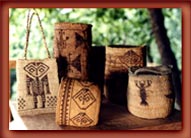
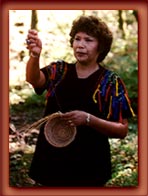
Nettie Jackson, Klickitat
"It was a special gifts right from the beginning for me and my People.
It was my Mother’s death that brought on this willingness and eagerness to learn this (basket making), I quit it about a thousand times when I first learned. It took me four years just to learn to process my own roots, to go up to the mountains, dig them out, and peel them down. Sometimes in one day what I get out of the ground will take me maybe a month to process.
"Baskets of the Northwest People"
Baskets of the
Northwest People"
A comprehensive study of exquisite baskets
woven in the Pacific Northwest,
circa 1860 to the 1930’s.
Nettie Jackson demonstrates Klickitat basketry.
Storyteller Johnny Moses sings an opening song
and tells a weaving story. Hosted by basketry expert
Natalie Linn.
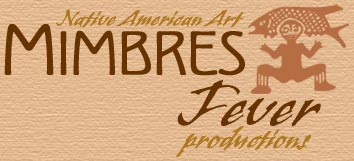 "Faithful to Continuance"
"Faithful to Continuance"Legacy of the Plateau People

Mimbres Fever Productions proudly announces the release of a new documentary exploring the
power and beauty of Columbia River Native American culture. Faithful To Continuance
weaves together exquisite artifacts with interviews from six exceptional Plateau artists
and one Treaty Fisherman.
Poet
"The sound of water tells the story well, in the sheen of river stone, a song is prevalent, faithful to continuance, the purity is a nuance, the memory, this certain way." Elizabeth reads from "Luminaries Of The Humble" and "Seven Hands, Seven Hearts", two books of poetry and verse on Plateau culture.

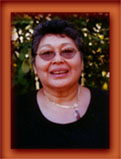 Lillian Pitt
Lillian PittSculptor
Lillian brings to life the spirit of her Ancestors. Motivated by rock art images along the Columbia River, she produces large scale metal sculpture as well as fine jewelry that reflects the 10,000 year tradition and beauty of her People. "Seeing the image of "She Who Watches" was a very profound moment for me because it let me know exactly who I am and it gave me a sense of power no one can remove from me."
Beadwork Artist
Maynard is carrying forward the traditional Plateau art forms he learned from his Grandmothers. He is an outstanding beadwork artist and a dedicated teacher of all aspects of traditional Plateau culture.
"It’s something that I hold very special to me, being born into a family of very knowledgeable elders in all aspects of our traditional life."
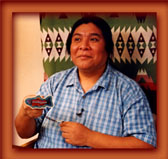
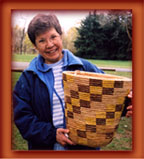 Elaine Timentwa Emerson
Elaine Timentwa EmersonBasket Weaver
Elaine is a well-respected artist and teacher of cedar bark basket weaving. "When I was growing up, we were not allowed to speak our language, we were punished. I think that’s what made me do the baskets. Also, I make baskets because I want people to know....we’re still here."

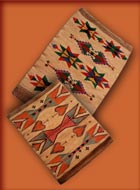
 Joe Feddersen
Joe FeddersenPrint Artist
Joe creates exquisite contemporary prints inspired by Plateau basketry and landscapes. "My work is about the quality of light and the feel of the landscape." Joe is also a very creative basket maker. He teaches at Evergreen State College.
Wasco Basket Weaver
Pat is restoring the art of Wasco basket weaving. With advice from elders in her community and guidance from basketmaker and writer Mary Schlick, she has relearned the art of full-turn twining. "My feeling of well being and happiness goes into this basket. It has part of my spirit in it...
my hope is that it will out live me."

 Clifford Shippentower
Clifford ShippentowerTreaty Fisherman
"It's our cultural identity really....the salmon are. Everything revolves around the salmon. We use it for ceremonial purposes, for memorials, funerals, namings. We pretty much get our nutrition from the fish, we get our strength from the salmon".
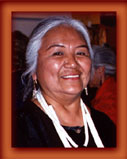
Vivian Harrison Stu Yat (pictured)
and Eugene Herrod
Faithful To Continuance is the fourth video in a series on Native American Culture, produced and distributed by Mimbres Fever Productions.
The Columbia River Plateau People are members of the Nez Perce, Colville, Umatilla, Yakama, and Warm Springs Nations. They reside between the Cascade and Rocky Mountain ranges and have a distinct and important culture which dates back ten millennia before first European contact.
Early Plateau People left the imprint of their culture on river rock in the form of pictographs, petroglyphs and sculpture; in exquisitely carved sheep horn bowls, in the shape and designs of their basketry, their hide dresses, their beaded cradleboards and bags; and in the hearts and spirit of their descendants.
Contemporary Plateau Native artists are maintaining and evolving the enormously powerful art expressions of their culture. Legacy of the Plateau People shows the genesis of Plateau design in prehistoric stone effigy sculpture and follows the development of Plateau design to contemporary work. Native artists discuss their work, traditions, and visions for the future. Explanations of traditional Plateau art expressions are interwoven with exquisite artifacts from both museums and private collections.
Saturday, June 3, 2006
Journey West
Thursday, June 1, 2006
Howling at the Moon
Pictures of Wolves. - A Native American Tribute American Indians. Native American Art. First People of America. ... Gray Wolf Pup - Quebec · Grey Wolf - Montana · Growling And Angry · Howling At The Moon ...http://www.firstpeople.us/pictures/wolves/10 ... 4x768/Alpha-Howl-1024x768.html
Wolf Pictures Gallery 1 Native American Indians. First People of America. First People of Canada. First People ... Growling And Angry · Howling At The Moon Howling At The Moon ...http://www.firstpeople.us/FP-Html-Pictures/wolves_pg1.html
Howling Wolf - Blue Moon by Oneta
These prints look so life-like, that many people have trouble telling whether they are the real feathers or not.

This beautiful wolf print features the unique art of ONETA and is hand signed by the artist. The original paintings, from which these prints are derived, are hand painted directly onto lovely natural feathers. ONETA's original paintings and prints are collected worldwide.
Howling at the Moon
Learning to Live With Wolves in the Romanian Foothills
by Chuck Todaro
Some 2,000 years ago, the barbarous Carpathian rulers known as the Dacians charged into battle against the invading Roman forces behind wolf-head banners. They were crushed and ultimately assimilated by the Romans. From this union of “wolf people” and the great Italian civilization under the sign of the she-wolf was born
the Romanians.

Romania has 3,500 wolves, and they’re becoming a tourist attraction as well.
© Photos to Go
Ever since, the wolf, or “lup” as the locals know it, has played an integral part in the Romanian culture and psyche. Today the Carpathian wilderness is home to more than a third of Europe’s large carnivore population, or 3,500 wolves, which is nearly as many as found in the entire U.S. The wolf is a major player in Romanian folklore, and retains a supernatural reputation. “Speak of the wolf and his tail appears” warns the old Romanian proverb. Christoph Promberger of the Carpathian Large Carnivore Project (CLCP), who has been researching the large carnivores of the southern Carpathian Mountains for the past 10 years, contends that his greatest finding is how easily carnivores can co-exist with people. In Romania, it’s not completely out of the ordinary to spot a bear leaning head first into a neighborhood dumpster. After all, an estimated 5,500 bears roam the Romanian territory, an area roughly equivalent in size to the state of Michigan. At the suburban apartment complex of Racadau, some bears have learned how wasteful humans can be and regularly descend from the hills to feed from garbage bins. Their scavenging has been so widespread that crowds gather in the street to await their arrival. “People still think that carnivores, and especially wolves, can’t live in proximity to humans,” says Promberger. “But just look at Yellowstone Park. People are getting scared that wolves are getting too close.” Though wolves have a sinister and near-mystical reputation, CLCP worked in conjunction with the British Broadcasting Corporation (BBC) to capture some extraordinary footage of wolves roaming unnoticed through rush-hour traffic on their way back from the local zoo, where they regularly venture for scraps of meat. The team was startled by the disinterested commuters, who treat these fierce hunters like common street dogs. “The wolf is a very adaptable species and has shown its ability to cope with high human densities,” says Luigi Boitani, a zoology professor at the University of Rome who has written a conservation plan for European wolves. “They know how to live among humans. It is up to us to show the same kind of adaptability and tolerance.” Romania today is still a fairytale land, with fabulous old architecture, horse-drawn carts in the roadways, peasants wielding huge sickles and hospitality like the olden days. Shepherding is still a large part of the economy. As in centuries past, shepherds still routinely herd their flock towards higher altitudes and greener pastures. And the wolves’ taste for sheep is the same as it always has been. Now and then, just like in the storybooks, a wolf slips in and steals one. Shepherd Gheorghe Corca has spent 30 years leading his flock into wolf territory, and has faced these large carnivores many times. Experience has made him more afraid of the wolf than the larger but more easily avoided bear. “The bear is heavy and you hear him step,” explains Corca. “But the wolf is a silent creature.” In 1997, CLCP started the country’s first ecotourism program and took its first step towards proving that humans can live and prosper around large carnivores. Zarnesti, 100 miles north of the capital city of Bucharest, sits right in the backyard of Dracula’s Castle. The old border town, whose Transylvanian-style homes stand like little gothic fortresses, dates back to the brutal Middle Ages, the era of Dracula model Vlad Tepes (known as “The Impaler” for his treatment of Ottoman Turkish prisoners). Zarnesti is a multi-cultural community, much as it was depicted in Bram Stoker’s novel, with Romanian, German and Hungarian names side by side on the tombstones in the town cemetery. And what Romanian town would be without its colorful gypsy settlement? Zarnesti has four. But while wolves and bears have thrived under the nation’s new protective environmental laws, the townspeople of Zarnesti have continued to struggle. Unemployment is still the town’s number one problem. The ecotourism program has done its share but only 150 people of the town’s 27,000 are directly affected. Hikers can be seen disembarking at the train station and marching in a line straight through town to the trails. The next day, they return leaving behind just their footprints. “So we had this idea to build a Large Carnivore Center,” says Promberger. “We are building it on the other side of town so that instead of simply flooding the environmentally sensitive areas, people would spend their nights in town, and visit restaurants and shops.” The center opens in 2005, covering 135 acres of protected Transylvanian land, with a lecture hall, classrooms and spacious outdoor enclosures for bears, lynx and the wolves “Crai” and “Poiana,” both rescued from a nearby fur factory. There will also be exhibition rooms dedicated to the large carnivores and their habitat. Carnivores are becoming central to Romania’s tourism industry. Promberger says, “When I first came here there were a lot of people who felt we were living in the Middle Ages because we had so many wolves running around. They thought we had to ‘solve’ this problem in order to join the West. Now this has changed. People see the wolves and bears as a heritage that Western countries have lost.”












